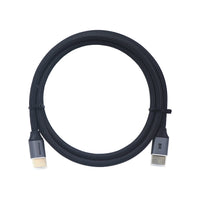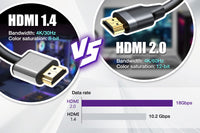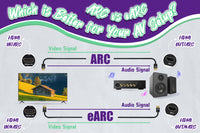Contents
As technology evolves, your computer and game console are equipped with newer ports. They have undergone a transition from traditional DVI to modern HDMI. DVI and HDMI may look different, but both are designed to carry uncompressed digital video to a TV or computer’s display. The main difference between the two is that HDMI can transmit both audio and video signals, while DVI can only carry video signals. Despite its limitations, DVI has still played a role in certain specialized areas. So, which one is right for you? In this post, we’ll guide you through the features of these two interfaces so that you can make an informed choice.
What is Digital Video Interface (DVI)?
DVI (Digital Video Interface), was first developed in 1999 to transmit uncompressed digital video to a display device such as a TV or computer monitor. DVI was an upgraded version of the VGA interface, making it popular for displaying high-definition resolutions in the early days.
DVI utilizes transition minimized differential signaling (TMDS) technology to transmit high-speed serial digital video data, avoiding distortion, electrical noise, and signal degradation. A single-link DVI supports up to 1920 × 1200 at 60 Hz by using four TMDS pairs, a dual-link can support a maximum of 2560 × 1600 resolutions at 60 Hz or handle more bandwidth generated by higher refreshes at lower resolutions.
There are mainly three types of DVI: DVI-A, DVI-D, and DVI-I. DVI-A only supports analog signals, which are often used to carry DVI signals to an analog VGA device. DVI-D supports digital signals and DVI-I can transmit analog-analog or digital-digital signals. DVI-I features VGA (Video Graphics Array) pins, so it is backward compatible with VGA interfaces.
DVI has been popular in the 2000s, especially for applications requiring high-definition video output. Though it has been outdated today, DVI can still be used in old systems.
What is High-Definition Multimedia Interface (HDMI)?
HDMI, also known as high-definition Multimedia Interface, was first developed with its 1.0 version on April 16, 2002. HDMI has surpassed its predecessor DVI as it cannot only transmit video data, HDMI but also compressed or uncompressed digital audio signals. HDMI cable is used to carry audio and video signals from an HDMI-compatible source device to an external device such as a computer monitor, soundbar, or digital TV.
To meet different requirements, HDMI has evolved through different versions, such as HDMI 1.4, HDMI 2.0, and HDMI 2.1. The HDMI 2.1 cable is an ultra-high-speed cable designed to support 48Gbit/s up to 10K at 120Hz. HDMI connectors can be divided into the following types: Type-A/Type-B, Type-C, and Type-D/Type-E.
HDMI CEC (Consumer Electronics Control) function allows you to remotely control different devices connected with an HDMI cable. In addition, higher versions of HDMI also have advanced functions like High-bandwidth Digital Content Protection (HDCP), which is designed to encrypt audio and video content.
Differences between DVI and HDMI
HDMI is an evolution of DVI with more advanced features. Let's take a look at the specific differences between them.
Construction
DVI and HDMI are easy to identify thanks to their different designs. DVI features a large rectangular shape and covers a larger footprint. Different DVI connectors have different pins. DVI-A has 11 pins, DVI-D features 19 pins for single link and 25 pins for dual link, DVI-I has 23 pins and 29 pins for single and dual link separately. In contrast, the HDMI connector has a slim rectangular shape with an angled edge. HDMI Type A connectors typically have 19 pins.
Signal Capabilities
DVI is designed to transmit both analog and digital video signals for some old monitors and video projects. This means that you need to find an extra cable used for sending audio information. DVI supports the bandwidth of 3.96 Gbit/s, up to 1920 × 1200 resolution at 60 Hz refresh rate in the single-link DVI connection, and supports the bandwidth of 7.92 Gbit/s, up to 2560 × 1600 resolution at 60 Hz in the dual-link DVI connection.
HDMI can handle high-definition video and up to 32-channel audio signals, making it a future-proof choice for modern displays. HDMI 2.0 supports up to 18 Gbit/s and ultra HD 4K resolution at 60 Hz, and HDMI 2.1 can carry a maximum of 48 Gbit/s bandwidth with a maximum resolution of 10K at 120 Hz.
Compatibility
DVI interfaces can often be found on computers and professional environments, especially in older systems. HDMI can be more common than DVI in the modern world. The compact and space-saving design makes it compatible with most modern devices including TVs, computers, monitors, laptops, and game consoles. HDMI is also backward compatible with older DVI interfaces with the use of adapters.
|
Comparison |
DVI |
HDMI |
|
Construction |
Rectangular; DVI-A:11 pins; DVI-D: 19 pins (single-link) and 25 pins (dual-link); DVI-I: 23 pins (single-link); and 29 pins (dual-link) |
Slim rectangular; Typically 19 pins
|
|
Audio and Video Support |
Only video |
Both video and audio |
|
Compatibility |
Old and legacy systems |
Most modern devices; backward compatible with DVI with adapters |
|
Bandwidth Support |
Lower |
Higher |
DVI vs. HDMI: Which Should You Choose?
When comparing DVI and HDMI, HDMI is generally the best choice for most setups. DVI focuses more on high-quality video output. If you are looking for a desktop computer and monitor with DVI ports only, DVI remains a reliable option for this traditional setup.
HDMI has become a ubiquitous option for a wide range of modern devices, including smart TVs, computers, laptops, PCs, smartphones, and gaming consoles. For most modern offices and home theater setups, HDMI is the best option integrating both audio and video capabilities. HDMI 2.1 supports Variable Refresh Rate (VRR) and Auto Low Latency Mode (ALLM), making it ideal for gamers who require an immersive and smooth gaming experience.

How to Get Audio From A DVI Interface?
DVI doesn’t transmit the audio signal itself. But if you are setting up a DVI connection with your computer and want to get audio from this connection, you have two options:
- Use a separate audio cable. You can purchase an additional audio cable to connect your computer and monitor, then you will get audio signals from the monitor’s built-in speakers.
- Use an HDMI-to-DVI adapter. You can buy a bi-directional cable or HDMI-to-DVI adapter, allowing you to get both audio and video information. If your TV or monitor features an ARC port, you can use the adapter over a single HDMI cable to get the audio from your computer and send video signals to your TV or monitor.
Final Thoughts
DVI and HDMI play an important role in transmitting digital high-definition video. The biggest difference is their audio output capabilities. DVI only supports video output, while HDMI supports both audio and video output. Though HDMI stands out for its integrated audio capacity, higher resolutions, and refresh rates in modern displays, DVI is still used for some old systems.
FAQs
1. Can DVI Cable Support 144Hz Refresh Rates?
In fact, DVI cables can support refresh rates up to 240 Hz for dual-link connections. But the refresh rate is limited by resolution, and sometimes you can’t get a higher resolution without an additional adapter.
2. Can I Switch from DVI to HDMI?
You can use an HDMI to DVI adapter to switch from DVI to HDMI signal or vice versa.
3. Is HDMI Better Than DVI for Gaming?
Yes, if your monitor supports higher HDMI versions and you want to use built-in speakers, HDMI is the best choice for video and audio connection.
For more information on this topic, you can keep up on our blogs. While VCELINK offers general and basic information for our customers and other visitors to the website, it’s not professional advice.






Be the first one to comment.
Leave a comment